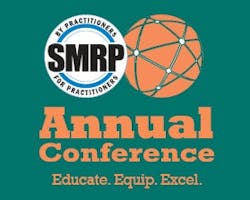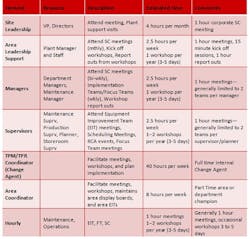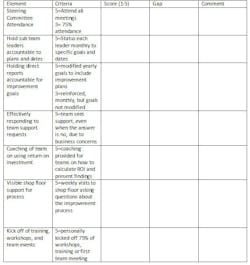Greg Folts, CMRP, president at Marshall Institute, will present “The Leadership Playbook: The Art of Making Your Vision a Reality” at the Society for Maintenance & Reliability Professionals Annual Conference in Orlando, Florida, on Oct. 22 at 1:15 P.M. The presentation will uncover the true art of leadership — the ability to engage others in making a vision into reality. It will share behaviors most proven to initiate and sustain improvement efforts. Practical ways to enhance leadership capability also will be provided. Learn more about the SMRP Conference at www.plantservices.com/smrp2014.
When deploying total process reliability (TPR) or a significant reliability improvement initiative, we often struggle with leadership’s role. Leadership knows they have to set expectations that lead to the right behaviors in the organization, but they’re not sure of proven methods to achieve this goal. Let’s explore the proven behaviors we need at the top of the organization to support deployment.
At the top of the organization we have executives that often have passion and vision around the TPR process, but they don’t have the time to support the day-to-day deployment. It’s critical that the deployment is delegated without losing accountability. We must rely on others to execute, but the leadership will need to retain responsibility for the deployment. This will mean that we must be involved with the development of goals and objectives and the monthly status of accomplishments. One technique we use to accomplish this “delegation with responsibility” is by participation on the site steering committee. Another technique is the creation of one-year and five-year plans. During the steering committee meeting, each team leader for key initiatives should report progress to a defined template or format. Key topics to cover should include:
- goals and deliverables
- accomplishment
- percentage completion to target
- obstacles
- support needed.
A second key element of leadership support is incorporating key actions and goals into performance measures for area and department leadership. If we can build key deliverables into the performance objectives of key leadership, we will affect and support the desired change. On the other hand, if key objectives are not incorporated in our goals, then we will have a negative impact on the deployment of the change. For example, if an employee’s bonus is tied to five key deliverables, none of which are directly tied to the reliability improvement initiative, where do you think he or she will focus efforts? While it might not be possible to change the performance indicators mid-year, we must make a direct linkage and frequent reinforcement. At the beginning of the year, we should directly align the goals.
When I was TPR manager, one of my significant culture shifts came from this principle. Each area manager was challenged with 10 key goals. Elements such as production, quality, safety, and delivery were combined with elements such as reliability improvement and PM compliance. Of 10 key goals, one or two were related to our improvement plans, and all 10 were tied to year-end bonuses.
Third, I would like to focus on supporting requests by the sub teams for support and resources. Special attention must be paid to ensure the teams see continued support. While there are no “blank checks,” the teams will use your support for requests as a gauge of your commitment. We should therefore pay very close attention to the way in which we respond to the request. In some cases you might say yes to a smaller request to show team support, even if the business case is not significant and if you feel that answer must be no, and take personal interest in communicating and coaching the team. I’ve found that teams need education on return on investment and creating a business case for improvement. They were good at seeing the need and intuitively knowing the need for change but not as good at converting this discovery into information that would show business leaders the value of the improvement. Coaching helped them to understand the value and effectiveness of speaking in a language that leadership can understand.
Finally, the fourth key element is shop floor visibility and inquiring about progress during shop floor visits or other meetings. A very strong message of what is important and what is not can be communicated through questions asked by top leadership. If six months ago we attended training, led a kick off meeting, or wrote an article (all good things to do), but we don’t show interest in progress (through meetings, shop-floor visits, or one-on-one conversations), the message is loud and clear.
Some key activities to consider:
- Ask often about progress, issues, and support.
- Kick off workshops, training, and overviews.
- Make spot visits to sub teams to show support and interest.
- Coach and provide feedback of both positive results and failure to meet objectives.
- Write articles and notes to show support.
This support should not take significant time, only prolonged focus. In as few as four hours per month a top leader can effectively show continued support for the process. These four hours could consist of a one-hour monthly steering committee meeting, a one-hour plant tour to check on shop-floor perspective, 30 minutes to kick off two workshops, time to send an email note of support, and participation in one department’s audit of practices. Again, this is less about a large focused effort in one month and more about sustained focus over multiple months. Table 1 gives some typical levels of support at various levels in the organization.
Table 1. A good way to evaluate your progress is to conduct a self-evaluation and have the teams that you are sponsoring evaluate your support.
A good way to evaluate your progress is to conduct a self-evaluation and have the teams that you are sponsoring evaluate your support.
Your evaluation should consider many of the factors listed in Table 1. Some elements could be key to your self-evaluation, while the other elements could be good for the team to evaluate (Table 2).
Table 2. Some elements could be key to your self-evaluation, while the other elements could be good for the team to evaluate.
Leadership is the art of involving others in the execution of a vision by inspiring, communicating, strategizing, training, and accountability. If we provide sustained leadership, we will help contribute to sustained improvement.




